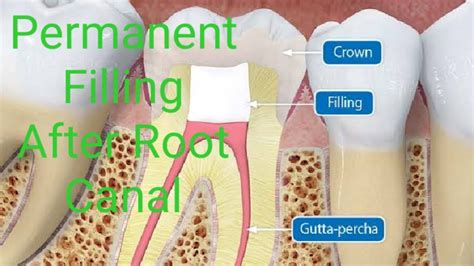Fast-Track Your Recovery: Permanent Filling After Root Canal
A root canal, while often perceived as a daunting procedure, is a highly effective way to save a severely damaged tooth. But the process isn't complete until a permanent filling seals the treated tooth, protecting it from future infection and ensuring its long-term health. This article will guide you through the post-root canal filling process, addressing common questions and concerns to fast-track your recovery.
What Happens After a Root Canal?
After a root canal, your dentist will temporarily fill the tooth to protect it until the permanent restoration can be placed. This temporary filling is usually a simple material that provides basic protection but isn't designed for long-term use. The temporary filling allows the treated area to heal and minimizes the risk of infection or further damage before the permanent restoration is cemented. This usually takes 1-2 weeks, allowing sufficient time for your gums and tissues to settle. During this period, you may experience some mild discomfort or sensitivity, but this should subside over time.
What Types of Permanent Fillings are Available?
Several types of permanent fillings are available for teeth after a root canal, each with its own advantages and disadvantages:
- Composite Resin: This tooth-colored material is aesthetically pleasing and bonds well to the tooth structure, offering a natural look. However, it may not be as durable as other options in areas under significant stress.
- Porcelain Inlays/Onlays: These are custom-made restorations crafted from porcelain, offering exceptional strength, durability, and a natural appearance. They're ideal for teeth with significant damage or those requiring extra support.
- Metal Fillings (Gold or Amalgam): While less aesthetically pleasing, metal fillings are incredibly durable and strong, making them suitable for high-stress areas of the mouth.
- Ceramic Crowns: A crown encases the entire tooth, providing the most comprehensive protection and restoration. It's a good option for severely damaged or weakened teeth.
Your dentist will recommend the best option based on your specific needs and the condition of your tooth.
What is the Process of Getting a Permanent Filling After a Root Canal?
The process typically involves:
- Removal of the Temporary Filling: Your dentist will carefully remove the temporary filling.
- Cleaning and Preparation: The tooth will be thoroughly cleaned and prepared to receive the permanent restoration. This may involve some shaping or contouring to ensure a proper fit.
- Placement of the Permanent Filling: The chosen material (composite, inlay, onlay, crown, etc.) will be precisely placed and bonded to the tooth.
- Final Adjustment and Polishing: The filling will be adjusted to ensure a comfortable bite and polished to achieve a smooth, natural finish.
How Long Does It Take to Get a Permanent Filling After a Root Canal?
The time required for a permanent filling placement varies depending on the chosen material and the complexity of the case. A simple composite filling might take just one appointment, while a crown may require multiple visits due to the need for impressions and laboratory fabrication. Your dentist will provide a detailed timeline during your consultation.
What Can I Expect During Recovery After Getting a Permanent Filling?
After receiving your permanent filling, you may experience some minor sensitivity to temperature changes or pressure for a few days. This is normal and usually subsides quickly. Follow your dentist's post-operative instructions carefully to ensure proper healing and prevent complications.
How Can I Care for My Tooth After a Root Canal and Permanent Filling?
Maintaining good oral hygiene is crucial for the long-term success of your root canal and filling. This includes:
- Brushing twice daily with fluoride toothpaste: Use gentle, circular motions.
- Flossing daily: Remove food particles and plaque from between your teeth.
- Using a mouthwash: This helps to kill bacteria and prevent infection.
- Regular dental checkups: Schedule routine visits for professional cleanings and examinations.
By following these guidelines, you can significantly extend the lifespan of your restored tooth and maintain optimal oral health.
What are the Potential Complications After a Root Canal and Permanent Filling?
While rare, potential complications can include:
- Infection: Although unlikely with proper care, infection can occur if bacteria invade the treated area.
- Fractured Tooth: If the tooth is severely weakened, it may fracture under stress.
- Sensitivity: Some sensitivity may persist, but it should subside over time.
Regular dental checkups and proper oral hygiene are key to minimizing these risks.
How Long Does a Permanent Filling After a Root Canal Last?
The longevity of your permanent filling depends on the type of restoration, the condition of your tooth, and your oral hygiene habits. With proper care, a permanent filling can last for many years, even decades.
This comprehensive guide provides valuable information about the permanent filling process following a root canal. Remember, consulting with your dentist is crucial for personalized advice and care. They can provide specific recommendations based on your unique needs and ensure the long-term health and success of your restored tooth.

